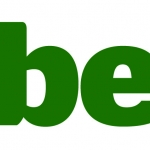Welcome Home
PHD Ireland and DDFH&B
Introduction & Background
This is the story of how communications helped the Irish government to mobilize a bankrupt and depressed society by creating a social movement that restored the tourism economy and the island’s national pride. This is how the power of communications and media turned a government initiative into a people’s initiative generating an impressive minimum return of 37:1.
“(The Gathering is) a scam to shakedown the Diaspora for money”
Gabriel Byrne, an Irish ambassador, on the Gathering in Nov, 2012
Introduction & Background
“The Gathering” is the largest tourism project undertaken by the Irish government since 1953. It was initiated by Fáilte Ireland (Ireland’s governmental body responsible for driving local tourism) in response to the alarming decline of the tourism industry. Ireland experienced a colossal -23% drop in tourism, in the short space of three years (2008-2010) as a result of the Irish and global economy collapse. This resulted in a -€1.6 Billion loss for the local economy. Urgent action was required but “The Gathering” would have to wait until 2013 given the scale of the initiative. Figure 1-3
“The Gathering” took inspiration from “The Homecoming” (Scotland, 2009); an initiative aimed at encouraging those with Scottish ancestral links to return home for a series of festivals throughout the entire year. Ireland, like Scotland, has a population phenomenon commonly referred to as “The Diaspora”, the surprisingly large collective of the island’s emigrants and their descendants living abroad. The Irish global diaspora has a population of seventy million people, sixteen times the population of Ireland.1 This phenomenon means that 4M Irish people living in Ireland are culturally and genetically connected to 70M people scattered around the globe. Figure 4
The mission was to motivate Irish individuals, living in Ireland, to reach out to the diaspora, inviting loved ones home to celebrate Ireland in 2013 at local and (predominantly) community-led events. In other words, the initiative relied on Irish people as the engine, the social propeller to give the Irish tourism a boost.
At this point one may think what could possibly be easier than asking the Irish to have a year of parties and celebrate their country and identity. That sounds like a dream brief (with a surely equally heavenly budget).
Well, we wish this had been the case. Instead we faced an enormous contextual and investment complication. From various research it was clear this was one of the worst times in recent decades to ask people to celebrate Ireland or to spend money on holidays. Ireland was bankrupt and people had lost belief in government initiatives. Plus, with an austerity plan of €28billion in place, the government could not waste a single penny.
Ad Effectiveness would not be a bonus. It would be a national duty to restore a crucial component of the economy2.The surprising success of the Gathering depended on a number of interwoven factors. Communications in Ireland was only one of these influencing factors so it would be disingenuous to attribute the entire success of The Gathering to the sole use of communications. However, throughout this paper, we will disentangle these factors to show the role domestic communications proudly played at ground level.
Figure 1
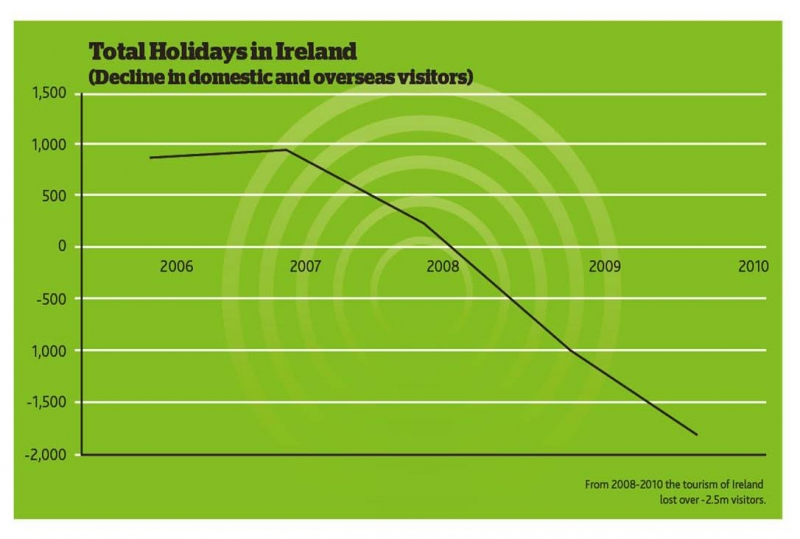 Figure 2
Figure 2
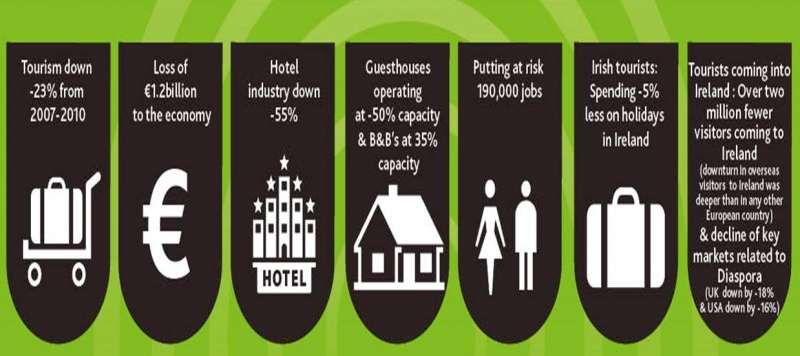 Figure 3
Figure 3

Figure 4

Marketing Objectives
Commercial objective: Increase tourism revenue by generating an extra €168 Million in 2013.1 This would be achieved through a combination of an increase in domestic tourism (Irish people holidaying in Ireland or attending events on the back of the initiative) and tourism from abroad (Irish global diaspora – or people who wish they were - coming to Ireland on the back of receiving a Gathering invitation from an Irish person).
Marketing Objective:
a. Mobilise Irish citizens, communities and businesses to work collectively to connect with the global diaspora by sending them an invitation or reason to visit Ireland during 2013. The objective was to encourage active participation of Irish people to create 2,950 gatherings attracting an estimated 107,500 additional visitors1. To put this ask into context, the government used Scotland’s Homecoming initiative in 2009 as a benchmark. Scotland successfully attracted 72,0002 additional visitors. This meant that Ireland’s ambitious goal was +49% higher than Scotland’s successful performance. (Please note that both countries have comparable population size: Scotland: 5.1 Million and Ireland: 4.6 Million people).

b. Create and renew connections that would deepen through 2013 and beyond, allowing the Gathering to build a lasting legacy for the tourism industry.
The role for Communications:
- Raise awareness and understanding of the Gathering in the space of four months: This was an entirely new concept for the country which required not just a high degree of mass awareness but given the complexity of the concept, it also required explanation. The task was to generate 80% of awareness and understanding in an incredibly tight window, from Sep’12 to Dec ’12, in the build up to 2013 – the year of The Gathering.
- Inspire consumer participation: Mobilize the population, across all counties to get involved by sending out invitations to attract almost 107,500 visitors from the diaspora; organising 2,950 community/personal gathering as well as attending the various Gathering related events planned for 2013.
Communications would have to overcome one particularly “tricky” challenge to deliver on the commercial objectives: getting Irish people to ACT, making “The Gathering” a people’s movement, not a government initiative. Simply put, the government could create the initiative but not the movement. The Gathering had to become a social movement as it relied on the millions of bonds and roots of families and friends that connect Ireland with the rest of the world.
Sources & References:
- Fáilte Ireland
- Scotland Government, Homecoming Final Report.
The Task
Our task represented a gargantuan challenge at five different levels:
- Trust & Belief: This was not a time to ask to Irish people to believe in government initiatives. The Gathering was an official initiative from “the enemy” at the time of launch:
- Ireland’s economy faced a debt of €70 Billion in 2008. As a result, an austerity plan imposed by the Irish government affecting 8 in 10 adults living in Ireland1.
- Levels of unemployment had spiralled out of control; jumping from +4.2% in 2007 to +14.6% in 2012. 2
- 34,500 young adults and families turned their backs on the country (the largest net emigration since 1989) leaving people mourning the loss of their communities.3
- 50% of people with mortgages were in negative equity. 4
- Nearly 40% of people blamed the government for the collapse of the Irish economy and their personal finances.5
In this context, the government had no place to talk to the people about “a year- long celebration”. What exactly was there to celebrate? Falling incomes? Increasing taxation?

Illustration 1: Gloomy headlines dominated the media for three years in the lead up to “The Gathering”.
2) Cultural task: This was certainly not a time to celebrate in Ireland
Irish people, usually ranked as the most content (and friendliest) nations around the globe felt depressed and hopeless: 6
- 74% of people felt hopeless and pessimistic about Ireland’s economic wellbeing.7
- Only two months away from the comms launch, over 50% of the population believed the economy situation in Ireland would keep getting worse.8
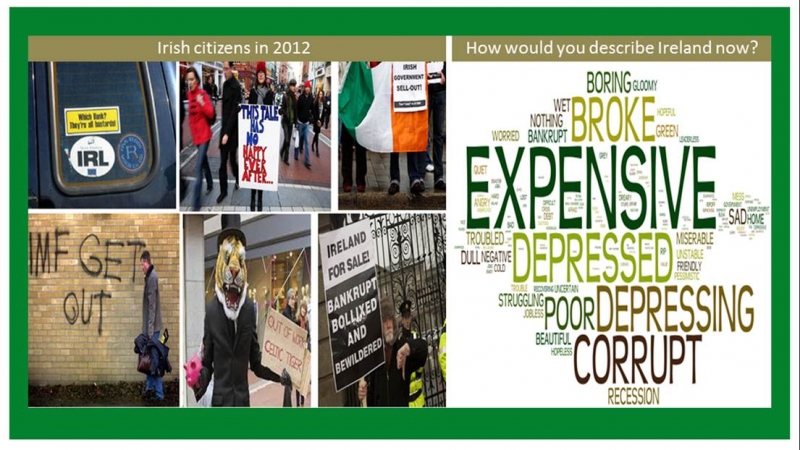
Illustration 2: Mood of the Nation in Q2 ’12 when The Gathering was officially launched by the Government.
- Financial Task: This was not a time to ask people to spend money on holidays, festivals or hosting their distant relatives/friends at home.
After three-four years of austerity, the impact had deepened:
- Disposable income was minimal: 46% of adults’ monthly saving was a mere €100 or under in Apr ’12.9
- 39% of people decided to take less holiday breaks in Ireland .10
- 67% of those who kept going on holidays reduced their overall holiday budget for the year in order to afford them. 11
This was a concern as the Gathering needed a personal and a financial investment from thousands of Irish people.
4) Behavioural: Getting involved in The Gathering was an enormous behavioural ask. This required a high degree of active involvement (higher than, for example, trying a new brand in a supermarket or switching a bill provider) and sustained involvement at various stages of the movement: Reaching out to the diaspora, creating a reason to come, organising a Gathering and attending a Gathering-related event throughout 2013.
5) Investment: The communications budget asking Irish people to get involved was minuscule when considering the task.
Strictly speaking, only 16% of the total budget was allocated to domestic comms12. Considering this budget had to cover Sep’12-Dec’13, the Gathering had an average monthly media budget of only €187,000 to create a national movement (making our budget -48% lower than the top brand investment in the Irish market13). This comms budget would have to literally work miracles.
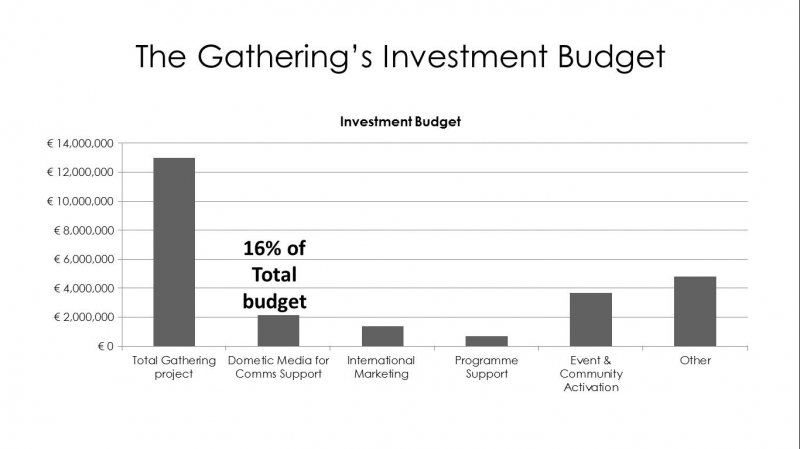
In addition to all the above, it became evident that a negative movement towards the Gathering quickly began after the official government launch. One of the most symbolic actions was the rejection of the invites to the official launch sent out to 1.6M Irish households; anecdotal information14 revealed Irish people returned their Gathering invitation postcards to Government buildings in protest. The Gathering became widely criticised by high-profile influencers like Gabriel Byrne and Ray D’Arcy, who questioned the very integrity of this concept. This meant our starting point for comms was not zero or neutral, it was negative.
Sources & References;
- ILCU, 2012. Base: All Adults
- Census Statistics Office Ireland
- Census Statistics Office Ireland
- Davy, Aug 2012.
- Laza Kekic, The Economist. Ireland ranked as the country with the highest worldwide quality of life index in 2005
- Red C 2011.
- The National Net Hope Index showed & Red C
- ILCU, April 2012.
- Online Survey, Fáilte Ireland & PHD. Base 500 National Adults
- Online Survey, Fáilte Ireland & PHD. Base 500 National Adults.
- Fáilte Ireland
- Nielsen Addynamix top brand investment in 2013
- Fáilte Ireland
The Strategy
In early 2012 the Gathering existed as an idea that was interpreted in different ways by different stakeholders. How could we hope to create a national movement when people did not have a shared understanding of what the Gathering was? This pointed to the need to think of the Gathering as a brand in its own right and there were three key factors that informed its development:
- Clarity: Ensure the target audiences understood what the Gathering was
- Distinctiveness: Carve out a space and identity for the Gathering
- Significance: Communicate the scale of the ambition
To ensure a clear and shared understanding of the Gathering brand we developed three elements to deliver brand coherence and discipline in implementation:

From the outset we recognised a long-term strategy would be required. This was not just a matter of launching the Gathering 2013. We needed to make sure the Gathering felt close and personal to people in communities across Ireland. Due to the complexity of the behavioural task, we developed a three phase communications strategy to ensure the overall objectives of the campaign would be achieved.
- Inspire: To impact all targets with the concept and create real presence and emotional engagement. Activate the nation from the local community up.
- Recruit & Enable: The Gathering initiation phase: modelling, staging and motivating to gain community and personal commitments to Gathering events.
- Go Live: Motivating Irish people to attend a gathering and share their experience. We launched the Gathering on the world stage on New Year’s Eve in Dublin to mark the beginning of this phase.
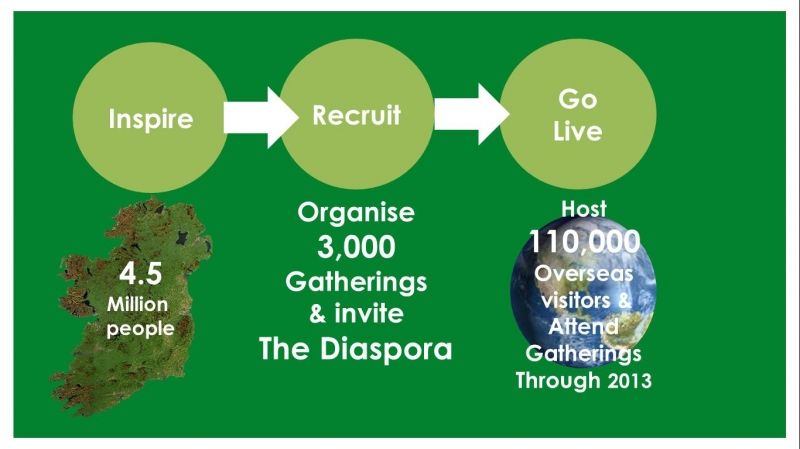
The strategy needed to be the first link in the chain and a clear foundation for what would become the Gathering 2013.
Interestingly, through early research in 2010 we discovered that underneath the humiliation, resentment and anger towards the government there was something positive. A large proportion of Irish people (over 71%) found appealing the idea of contributing at a personal level to the re-building of Ireland.1 They were not proud of the current Ireland (2008-2012) but they were intensely proud of their roots. This insight grounded our strategy: we would use communications to help Irish people travel the long distance between the turbulent present full of cynicism and the idea of a better future re-built with the help of communities. This became our strategic journey: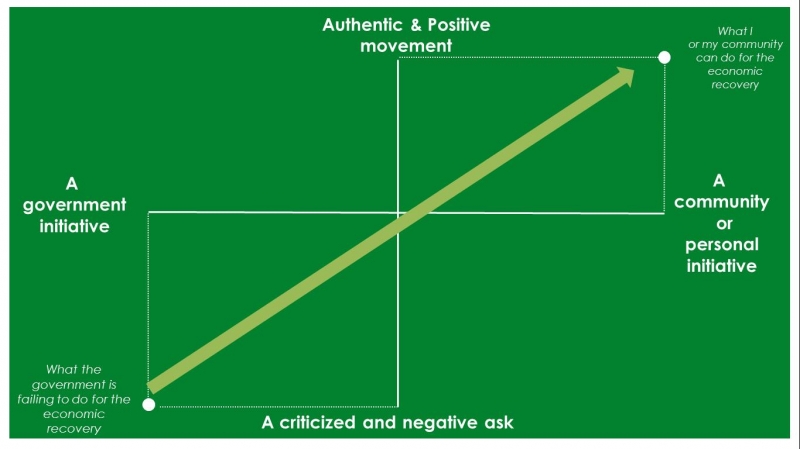
Sources & References:
- Online Survey, Fáilte Ireland & PHD. Base 500 adults.
The Idea
It would have been disingenuous for a government body to invest in a flashy above-the-line campaign: the typical big-budget-TV packed with Irish A-listers (although we had thought of that: Bono, Michael Fassbender, Colin Farrell and Gabriel Byrne asking Irish people to host and finance The Gathering 2013). However, this approach felt glossy, shallow and even obvious. It would have been the wrong message at the wrong time and we would have likely experienced the “postcard protest” on a much grander scale.
However, it’s one thing to know what needs to be done and quite another to do it- especially with a small window of opportunity that was beginning to close, four months (from the launch of comms in Sep’12 to “Go Live” in Jan’13 to create the sense of a movement).
The comms ambition was to make this a “peoples’ movement”; to make them the driving force behind the Gathering. This desire to make it “of the people”, to make it feel close and personal to everyone across Ireland was central to the creative strategy. We wanted people to participate, however they chose to. We wanted everyone to “be part of it”. This was an important construct as it became an invitation to get involved at whatever level was right for every person. It did not challenge or instruct. It was not forceful. Instead it was humble; a sort of casual call to join in.

This simple idea was crucially distinct when compared to the bulk of the activity run by the vast majority of tourist boards. It was not about showing aerial shots of beautiful scenery or picture-perfect-post-card landscapes of Ireland. It wasn’t asking Irish families and communities to bring tourists all over Ireland drinking Guinness or kissing the Blarney Stone, relying on stereotypical touristic activities. Instead, it gave people a chance to join a movement in their own terms; creating a gathering that actually meant something to their family, ancestors or their community.
This idea allowed people to decide not only how they wanted to join (it could be inviting one friend from Australia or the entire clan from Canada) but it also allowed people to decide how they wanted to present Ireland to the Diaspora: friendly Ireland, rural Ireland, modern Ireland, creative Ireland… Allowing each and every person to define the nature of their gathering brought in authenticity to the movement. This authenticity brought in credibility, affinity and the emotional aspect to the movement that was much needed. With this in mind, the creative focus moved away from putting the government as the hero of the movement and instead focused on the authenticity of Irish families, communities, groups of friends.
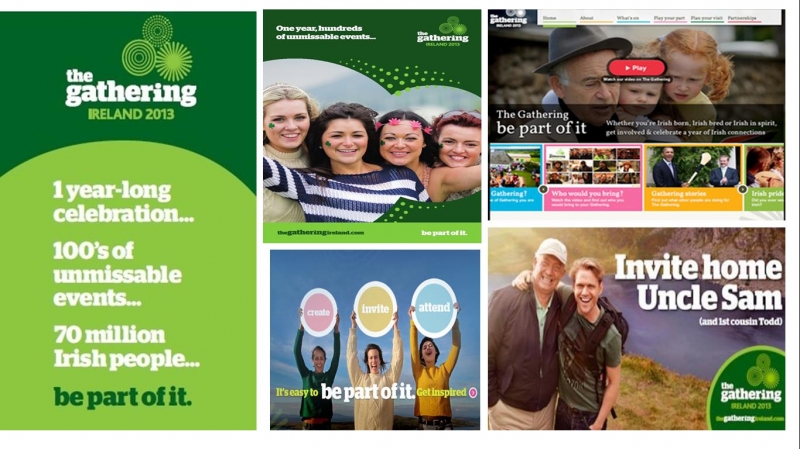
We wanted “lightness” in the tone and this was manifested across in all the channels as we’ll explain below.
From a media perspective the use of channels would be crucial to allow people to feel “part of it”. This needed a distinct approach to the traditional one:
- The most common use of channels for governmental and brand campaigns in Ireland is TV as the lead medium and this is then supported by high-impact formats in other traditional media channels (Full Page ads in press anyone?).
As we knew it was important to move away from the big-brand-TV-ad, this meant no traditional TV support and not relying on the comfort of TV delivering a solid and constant mass reach throughout 2013.
- We knew that an average monthly budget of €180k was in high risk of not achieving cut-through (as referenced in the Task section) so a non-traditional approach would be needed.
- We were not after clicks or digital impressions. We weren’t even content with achieving the awareness KPI’s. The real KPI’s was to inspire people to be part of it at ground level.
Media had to become more than the vehicle for awareness and understanding of the initiative. It also had to provide the tools required for Irish people to create a movement in and beyond the isle. In other words, media had to help transfer the power of the initiative from the government to the Irish people.
This led us to four simple principles for the use of channels:
- Social and digital media would take-over from TV and traditional channels as the lead medium. This would allow us to transfer the ownership of the movement from the government to the social communities. Whilst risky (as it could generate negative WOM and it did at the beginning), it had been proven social media increased the feeling of being connected in 76% of adults, which was much needed to create a sense of movement. 1
- Converge all media efforts on digital media channels when helping Irish people to invite the Irish diaspora, making participation easier at various stages of the journey.
- Use media to support community gatherings when possible accentuating the importance of the authentic involvement of people around the country.
- Take the content-creation principle commonly applied to digital media channels and transfer it to other traditional channels. This would weave in authenticity and allow Irish people to be part of the Gathering’s media.
These principles were then applied to the media activations which mirrored the overall communications phasing strategy:
Inspire (Join the movement)
- We started by holding and informing people about community meetings. These meetings may not have been a glamorous use of media but we knew that we had to start by informing local communities and families to create authentic buy-in and WOM. This marked the beginning of our social media campaign to inspire people.
- We produced the first online magazine through two print partnerships with both the Irish Times and the Irish Independent, inspiring readers to re-engage with what modern Ireland has to offer interactive.
- Under our content-transfer principle, we created a brand new six-week primetime TV and VOD series called “Homeward Bound” with Ireland’s leading TV channel, RTE. Six well-known Irish celebrities (such as Riverdance sensation Jean Butler), who are based abroad, returned to their home place to help these communities prepare for The Gathering. The main goal was to inspire ordinary Irish people in their local area to join in using a homely and friendly approach.
- We partnered with Today FM to create the first diaspora content-partnership, sending the well-known Irish radio station’s presenters to destinations around the globe where there are high concentrations of Irish descendants or citizens such as Boston, USA. We convinced TodayFM to broadcast from these locations inspiring listeners tuning in from Ireland to get in touch with the global Irish diaspora.
- An OOH campaign targeted pockets with high concentration of tourism attractions reminding our audience of the inspiring heritage and Irish wonders they could share with their relatives/friends around the world.
Recruit and Engage (Invite others to join)
- We launched the “Invite & Attend” social app allowing people to search for Gatherings in their area or Gatherings that were of interest to them.
- Digital media created alerts and reminders informing people they were still in time to join the movement and invite people home.
- We invested in Twitter promoted content with an Invite message tapping into cultural roots and innovating with the first tweets in the country in the Irish language.
- We evolved the search and analytics campaign from an awareness focus to a call for participation to join the movement.
- We supported the digital media described above with a national radio campaign raising mass awareness of the digital channels recruiting Irish hosts.
Live (Be part of the live movement)
- Digital and social media allowed us to show in real time what was happening around the Gathering and also collect the stories of people who were part of it creating a sense of momentum and movement.
- We created an incredibly meticulous and detailed active social content calendar promoting over 250 gatherings.
- Search and analytics strategy targeted the specific themes and interests around specific Gatherings being organised i.e. Irish food, sport, culture marrying the interests of the general public with the specialised gatherings to drive attendance and participation.
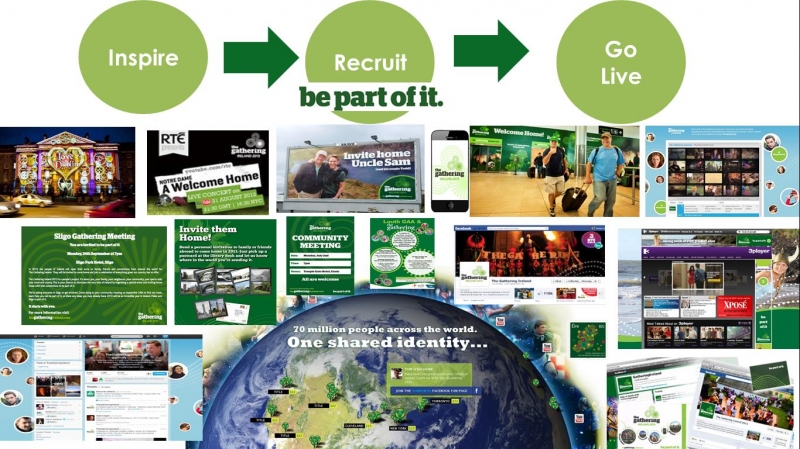
Sources & References:
- Nielsen State of Media, 2012
The Results
7.1 Business results: Revenue target attributed directly to the Gathering (not tourism in general) was exceeded in the first ten months of the year by +19%.
Whilst the final domestic figures for Q4 haven’t been released, we have conservatively estimated the forecast of the total year performance by applying a +1% growth to the Q4 (this is a conservative estimation considering Q3 experienced growth of +5%).
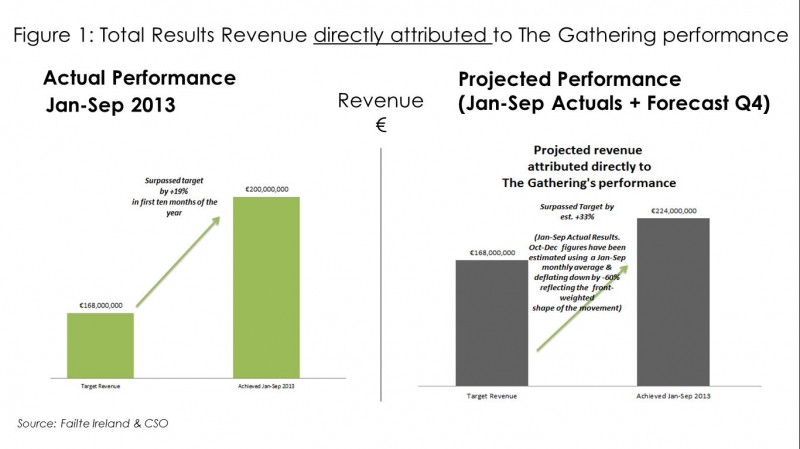
This directly impacted a number of key metrics in the tourism industry:

7.2 Marketing results: Target was surpassed by +69%. Please note this figure only reflects the Gatherings that were officially registered. The personal nature of the gatherings meant that not every family or community publicly registered their gathering online. None of these “unofficial” gatherings are included below:
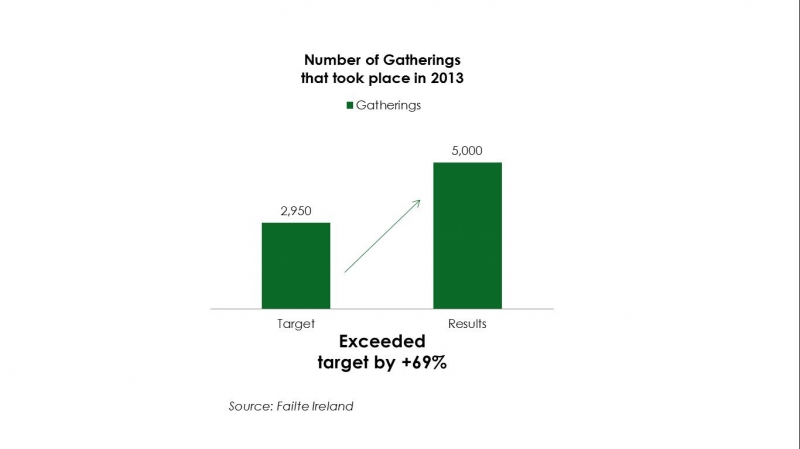 The target around visitors uplift was surpassed over +300% in the first ten months of the year (Q4 results have not been published yet). When comparing these results to Scotland’s Homecoming, the only benchmark available, The Gathering surpassed Scotland’s results in actual visitor numbers by +511%.
The target around visitors uplift was surpassed over +300% in the first ten months of the year (Q4 results have not been published yet). When comparing these results to Scotland’s Homecoming, the only benchmark available, The Gathering surpassed Scotland’s results in actual visitor numbers by +511%.

7.3 Communications- The way the campaign worked:
After doing the “heavy lifting” from Sep-Dec ’12, awareness and understanding targets were exceeded by +5%.
The below shows a clear correlation of awareness, understanding being driven by the launch of comms.
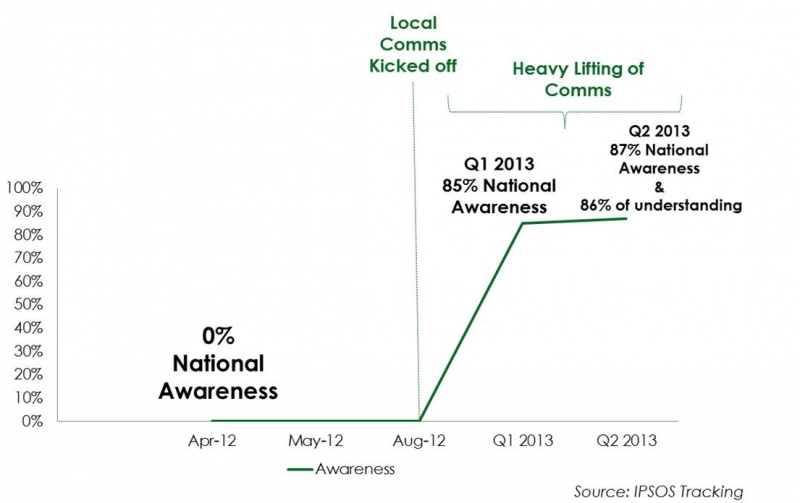
We rapidly increased the active participation. Before comms launched there was little to none interest or understanding on how to take part. However, by Q1 ’13 an impressive 23% of people had already sent out an invitation and 43% of people wanted to get involved.
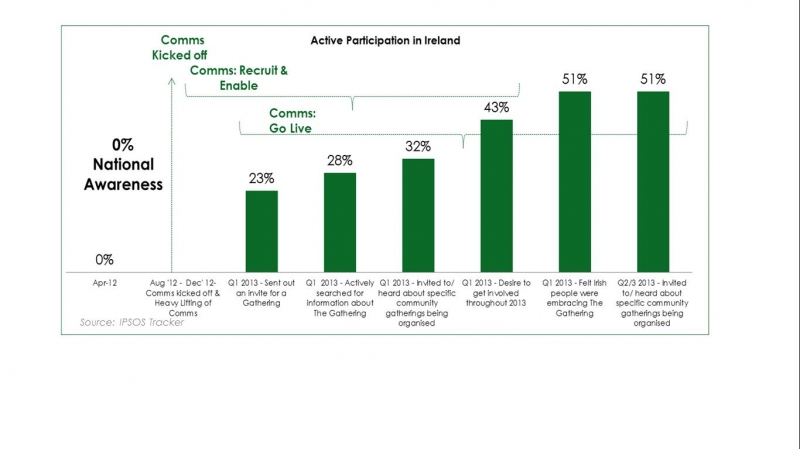 Comms empowered people to actively seek involvement: 28% of people searched for The Gathering in Q1 and 24% of people went straight to the Gathering website. Through 2013 the website generated 2.2 million site visitor sessions and 1.5M unique visitors went to the “attend a gathering” section.
Comms empowered people to actively seek involvement: 28% of people searched for The Gathering in Q1 and 24% of people went straight to the Gathering website. Through 2013 the website generated 2.2 million site visitor sessions and 1.5M unique visitors went to the “attend a gathering” section.
However, success was not measured by only studying “intent”/“interest” related metrics. The chart below reflects a clear mirroring of gatherings organised/registered online and the media investment in Ireland.
Media investment and Gatherings organised by month
This key chart shows how participation peaks right after investment peaks too, demonstrating the direct correlation of comms investment triggering participation.
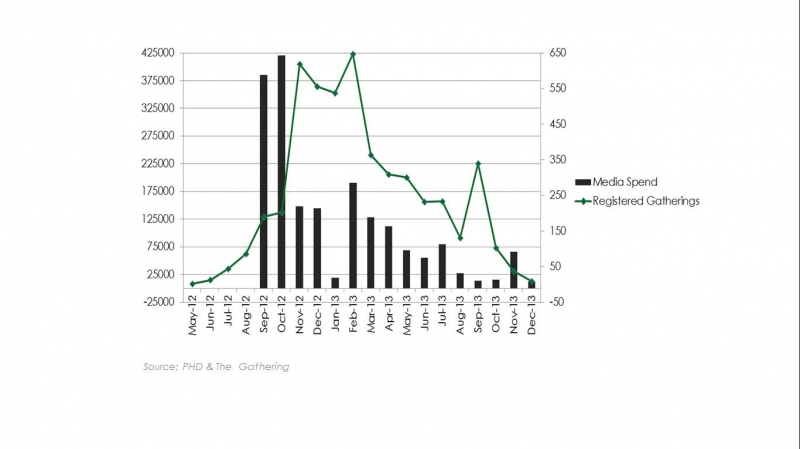 The use of media earned The Gathering the GRAND PRIX and GOLD (Travel and Tourism) earlier on this year at the Digital National Awards. It is an honour to be recognised for best use of practice but the most precious reward is the astonishing levels of participation; by the end of the campaign an impressive 1.5 Million people got involved which equates to 35% of people in the country.
The use of media earned The Gathering the GRAND PRIX and GOLD (Travel and Tourism) earlier on this year at the Digital National Awards. It is an honour to be recognised for best use of practice but the most precious reward is the astonishing levels of participation; by the end of the campaign an impressive 1.5 Million people got involved which equates to 35% of people in the country.
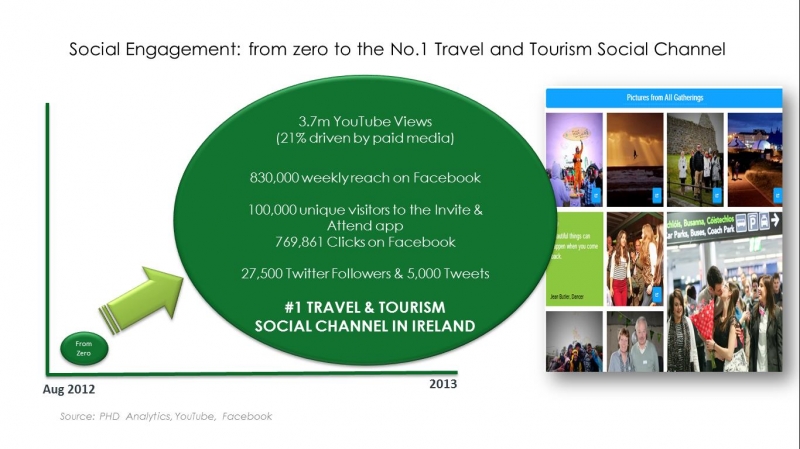

Therefore, there was a stunning 40% conversion from awareness to participation:
Local comms succeeded at making Irish people act
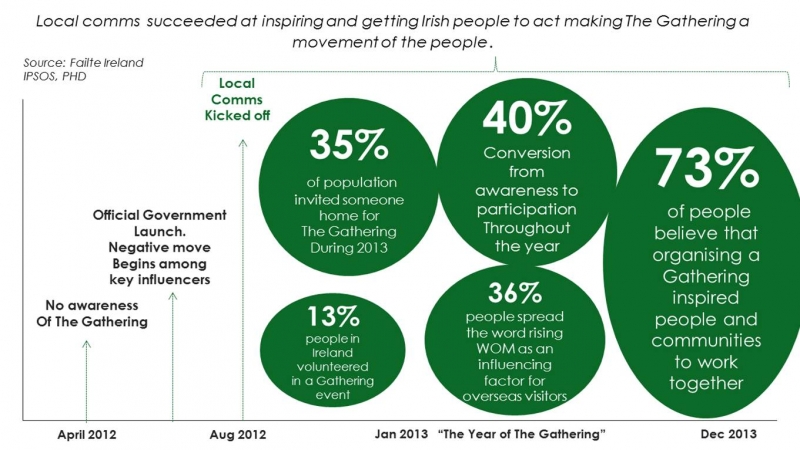
7.4 Discounting Factors:
What about the visits or the holidays in Ireland that would have taken place anyway?
The results quoted on the result section (7.1, 7.2 & 7.3), are results/growth directly attributed to The Gathering. The leisure visits that would have taken place anyway or as the result of the natural recovery of the economy have not been taken into account.
Were there incentives for the Irish public or Diaspora to get involved?
There were no incentives for members of the public to organise personal/ family gatherings or for the Diaspora to attend. Their only reward was to be reunited with loved ones and enjoy time together.
Was the weather an influencing factor in the success of The Gathering?
No, this wasn’t the case as the majority of The Gatherings (43%) were registered an average of 4-6 months before the good weather arrived in Ireland. This means the vast majority of the gatherings were planned long before there was any knowledge of good weather in the summer of 2013.1
Were there more events in Ireland attracting more tourism in 2013?
There were more events in Ireland in 2013 but the vast majority of events were the actual gatherings the communities or families organised as a natural result of the movement.
Did Fáilte Ireland invest more in media 2013 than it did in other years adding to the success of The Gathering?
No, in fact Fáilte Ireland invested less in 2103 than it has in previous years. Their budget encouraging Irish people to holiday in Ireland decreased by -32% YOY in the year of the Gathering.
Did Tourism Ireland invest more in media 2013 than it did in other years adding to the success of The Gathering?
No, Tourism Ireland’s budget remained the same in 2013 as in previous years
Did Ireland’s competitors spend less making it easier to persuade Irish people to stay in Ireland?
No. The Gathering’s €3M comms domestic budget was playing against a massive €36M of media budget attracting Irish people away from Ireland, to less expensive and sunnier destinations; even Northern Ireland’s tourism board had a higher budget than The Gathering’s (NITB budget was €3.2M Aug ’12- Dec ’13).
The figure below shows investment of the Gathering Vs the investment of other tourism boards, international airlines and tour operators strictly promoting other destinations other than Ireland.
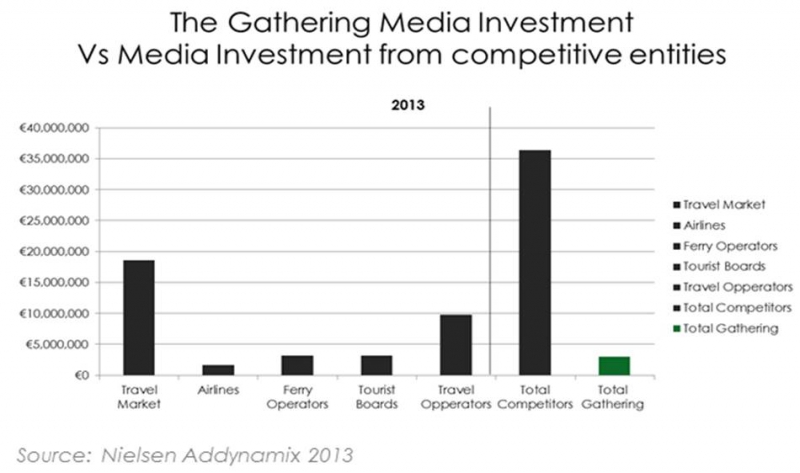
Counting Factors
There is one factor that we should take into consideration. In June 2012, the government introduced a reduced rate of VAT from 13.5% to 9% to travel and tourism. This was extended through 2013 which could have partially motivated Irish families/individuals to invest in the costs associated with hosting or attending a Gathering. However, this would have impacted the budget available as opposed to levels of participation.
- ROMI
The results generated in the first ten months of 2013 show there were 5,000 gatherings organised in Ireland bringing an additional 440,000 tourists. This is worth an additional €200M to Ireland’s tourism economy. The total campaign expenditure was €13M with the total Marketing budget being €5M. The initiative was delivered within budget giving us an exceptional ROMI of 37.4:1.
If we wanted to be even more conservative (knowing that the ROMI above does not include the additional revenue from Q4 2013 as official domestic figures have not been officially released yet), we could conservatively estimate that Irish people, as the engine of the movement, were responsible for a half of the success in attracting visitors (the other half being the visitors from abroad who came to Ireland specifically because of the Gathering). This would give us a humble estimation of a ROMI of 18:1 considering the movement was both initiated and hosted in Ireland.
Long-term payback:
43% of organisers plan to repeat gatherings and 56% of overseas visitors plan to return to the country as a result of attending The Gathering. It wouldn’t be accurate to assume that every person who plans to host or to return will do so. However, even if only 10% of those involved gather again, that alone will generate €20 Million to the economy.
7.7 Manifold effects:
The Gathering increased national pride and belief in the communities. This is important as the Gathering was not just about visitor numbers and revenues. It was also about community pride.
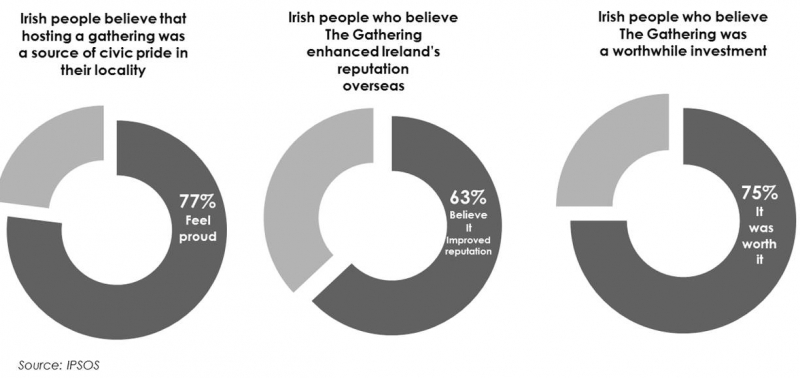
7.9 Long term effects: The Legacy of The Gathering is one of the most worthy results. Whilst there was a hope the Gathering would impact the tourism industry long-term, it was impossible to attempt to quantify the effect before 2013. However, post-campaign results show that a spectacular 32% of businesses in the tourism industry believe they will continue to benefit in 2014.
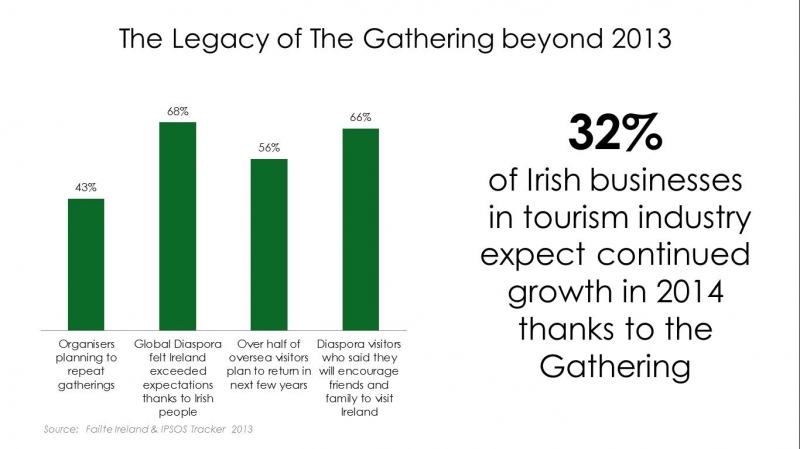
Finally, while the economy began slowly recovering, the tourism industry clearly got a helping hand from The Gathering:
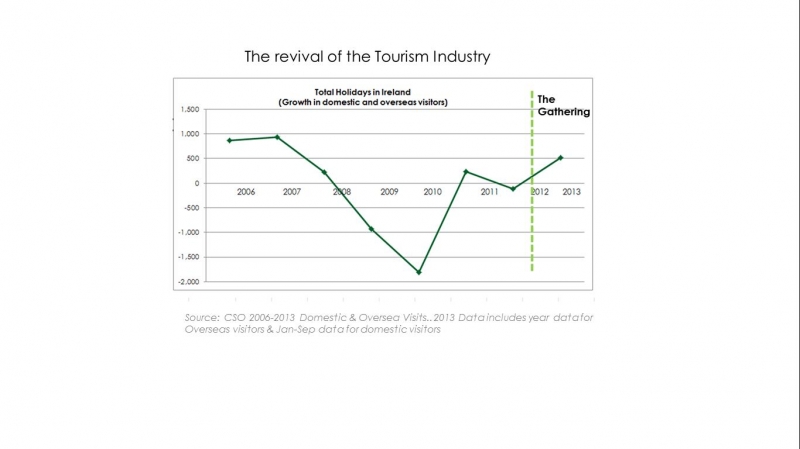
Sources & References:
Discounting Factors:
- (The most official weather predictions don’t forecast for longer than 30+ days and in fact, summer 2012 showed Ireland’s summer was grim and miserable making the weather a highly unlikely factor of success).
- In fact, research shows the majority of the gatherings (over 56%) were family, clan and communities celebrating The Gathering. The remaining gatherings celebrated culture, heritage, old-school links, corporate, education or special interest-led gatherings.
The Impact
The influence of communications which strategically set out to get people in Ireland to take ownership of the movement is reflected when comparing the before and after of the behavioural attitudes. There was a clear shift achieved at a mass level, going from negative/ neutral to positive attitudes:
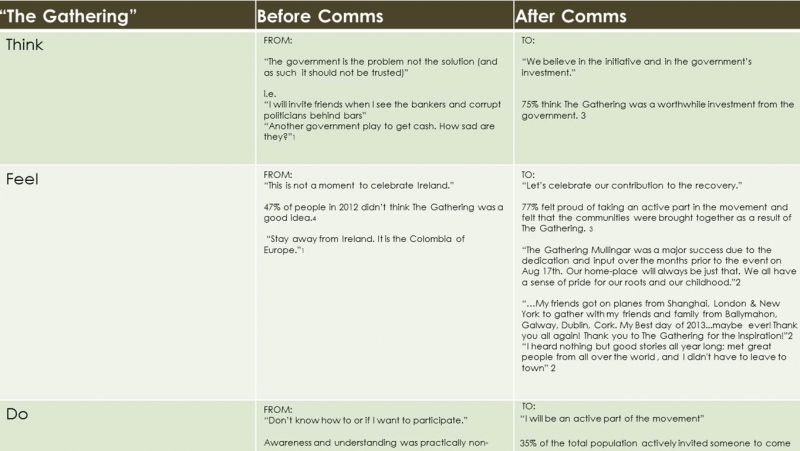
Additionally, the trade audience was also positively impacted by the initiative and the support it received through communications. The trade felt supported and grateful towards the initiative. More importantly, the trade felt connected to The Gathering; a real affinity for the authenticity of the movement.
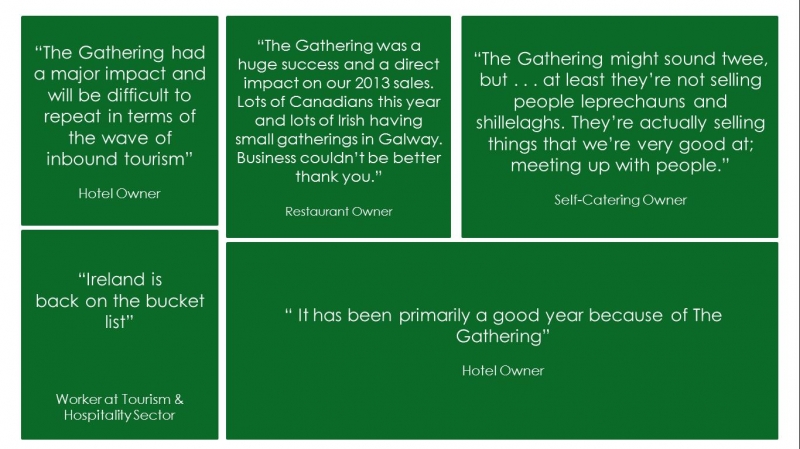
This behavioural change required for success was one of the most challenging cultural campaigns the government (and us) has ever faced: creating a national (tourism) movement that would in turn create a global movement injecting revenue growth into Ireland. We took a criticized initiative by a resentful audience and help to make it a national movement and source of civic pride.
The journey of The Gathering was more than worth it. It brought in €200M and Irish people working together. We didn’t change Irish people. We only helped them capitalize their best asset: themselves, their hospitality and culture. They believed, they invested and they invited in their thousands…
“The Gathering has been more a movement through tourism by small communities: what can our town or village do to attract tourists and make them stay longer? …That will be our on-going legacy.”
Hotel Owner
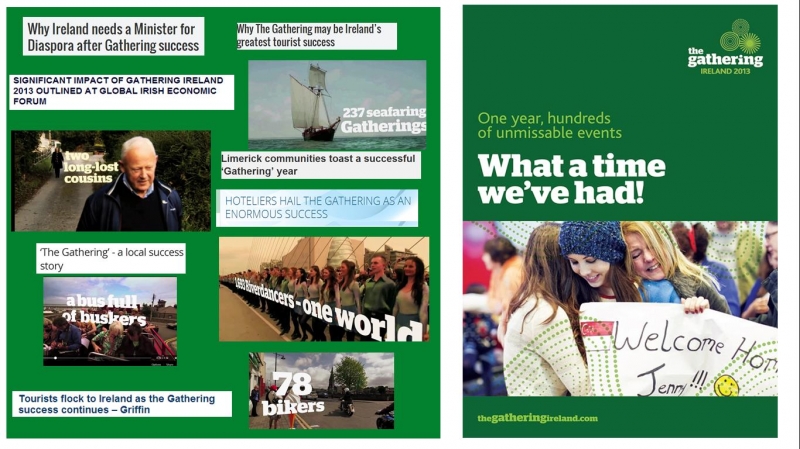
Sources and References:
1. Facebook posts left on The Gathering Facebook page, 2012
2. Facebook posts left on The Gathering Facebook page, 2013
3. IPSOS Research, 2013
4. The Journal Research, 2012
5. Fáilte Ireland
New Learnings
a) Strategically, we discovered the depth of the behavioural ask required a distinct approach: to create a genuine movement – a term used often abused by many brands- and change radically the domestic behaviour, it was required to approach the case strategically and creatively as a new brand entity.
b) From an investment POV, this case marked the beginning of social media channels as brand building channels, not just as engagement channels. This is a particularly crucial learning because up until now brand-building tasks have been predominantly reserved for TV and OOH channels in Ireland. Planning wise, using social channels enabled us to build a brand at a mass level as well as mobilizing the population (and quantifying this mobilization). Trading wise it allowed us to elongate the number of weeks we were active by an estimated 42% (as TV/OOH campaign would have “swallowed” the media budget at a faster rate than social media did).
Summary
In 2013 the Irish Government undertook it’s largest ever tourism initiative after a colossal 23% drop in tourism. The initiative was called, The Gathering. A movement that asked 4M Irish people to reach out to the 70M Irish global diaspora, inviting loved ones home to celebrate Ireland in 2013. The communications challenge was to go from zero awareness to a full blown social movement at a time when people had no belief in the Irish government and the economy was bankrupt. This required creating a shift in five different levels: behavioural, cultural, financial, trust and investment. We created a simple idea called “Be part of it”; and by building a new brand using predominantly social and content media we engaged 35% of the population exceeding targets of €168 Million by 19%.
This is the story of how communications helped the Irish government to mobilize a bankrupt and depressed society by creating a social movement that restored the tourism economy and the island’s national pride. This is how the power of communications and media turned a government initiative into a people’s initiative generating an impressive minimum return of 37:1.
“(The Gathering is) a scam to shakedown the Diaspora for money”
Gabriel Byrne, an Irish ambassador, on the Gathering in Nov, 2012
Introduction & Background
“The Gathering” is the largest tourism project undertaken by the Irish government since 1953. It was initiated by Fáilte Ireland (Ireland’s governmental body responsible for driving local tourism) in response to the alarming decline of the tourism industry. Ireland experienced a colossal -23% drop in tourism, in the short space of three years (2008-2010) as a result of the Irish and global economy collapse. This resulted in a -€1.6 Billion loss for the local economy. Urgent action was required but “The Gathering” would have to wait until 2013 given the scale of the initiative. Figure 1-3
“The Gathering” took inspiration from “The Homecoming” (Scotland, 2009); an initiative aimed at encouraging those with Scottish ancestral links to return home for a series of festivals throughout the entire year. Ireland, like Scotland, has a population phenomenon commonly referred to as “The Diaspora”, the surprisingly large collective of the island’s emigrants and their descendants living abroad. The Irish global diaspora has a population of seventy million people, sixteen times the population of Ireland.1 This phenomenon means that 4M Irish people living in Ireland are culturally and genetically connected to 70M people scattered around the globe. Figure 4
The mission was to motivate Irish individuals, living in Ireland, to reach out to the diaspora, inviting loved ones home to celebrate Ireland in 2013 at local and (predominantly) community-led events. In other words, the initiative relied on Irish people as the engine, the social propeller to give the Irish tourism a boost.
At this point one may think what could possibly be easier than asking the Irish to have a year of parties and celebrate their country and identity. That sounds like a dream brief (with a surely equally heavenly budget).
Well, we wish this had been the case. Instead we faced an enormous contextual and investment complication. From various research it was clear this was one of the worst times in recent decades to ask people to celebrate Ireland or to spend money on holidays. Ireland was bankrupt and people had lost belief in government initiatives. Plus, with an austerity plan of €28billion in place, the government could not waste a single penny.
Ad Effectiveness would not be a bonus. It would be a national duty to restore a crucial component of the economy2.The surprising success of the Gathering depended on a number of interwoven factors. Communications in Ireland was only one of these influencing factors so it would be disingenuous to attribute the entire success of The Gathering to the sole use of communications. However, throughout this paper, we will disentangle these factors to show the role domestic communications proudly played at ground level.
Figure 1
 Figure 2
Figure 2
 Figure 3
Figure 3

Figure 4

Commercial objective: Increase tourism revenue by generating an extra €168 Million in 2013.1 This would be achieved through a combination of an increase in domestic tourism (Irish people holidaying in Ireland or attending events on the back of the initiative) and tourism from abroad (Irish global diaspora – or people who wish they were - coming to Ireland on the back of receiving a Gathering invitation from an Irish person).
Marketing Objective:
a. Mobilise Irish citizens, communities and businesses to work collectively to connect with the global diaspora by sending them an invitation or reason to visit Ireland during 2013. The objective was to encourage active participation of Irish people to create 2,950 gatherings attracting an estimated 107,500 additional visitors1. To put this ask into context, the government used Scotland’s Homecoming initiative in 2009 as a benchmark. Scotland successfully attracted 72,0002 additional visitors. This meant that Ireland’s ambitious goal was +49% higher than Scotland’s successful performance. (Please note that both countries have comparable population size: Scotland: 5.1 Million and Ireland: 4.6 Million people).

b. Create and renew connections that would deepen through 2013 and beyond, allowing the Gathering to build a lasting legacy for the tourism industry.
The role for Communications:
- Raise awareness and understanding of the Gathering in the space of four months: This was an entirely new concept for the country which required not just a high degree of mass awareness but given the complexity of the concept, it also required explanation. The task was to generate 80% of awareness and understanding in an incredibly tight window, from Sep’12 to Dec ’12, in the build up to 2013 – the year of The Gathering.
- Inspire consumer participation: Mobilize the population, across all counties to get involved by sending out invitations to attract almost 107,500 visitors from the diaspora; organising 2,950 community/personal gathering as well as attending the various Gathering related events planned for 2013.
Communications would have to overcome one particularly “tricky” challenge to deliver on the commercial objectives: getting Irish people to ACT, making “The Gathering” a people’s movement, not a government initiative. Simply put, the government could create the initiative but not the movement. The Gathering had to become a social movement as it relied on the millions of bonds and roots of families and friends that connect Ireland with the rest of the world.
Sources & References:
- Fáilte Ireland
- Scotland Government, Homecoming Final Report.
Our task represented a gargantuan challenge at five different levels:
- Trust & Belief: This was not a time to ask to Irish people to believe in government initiatives. The Gathering was an official initiative from “the enemy” at the time of launch:
- Ireland’s economy faced a debt of €70 Billion in 2008. As a result, an austerity plan imposed by the Irish government affecting 8 in 10 adults living in Ireland1.
- Levels of unemployment had spiralled out of control; jumping from +4.2% in 2007 to +14.6% in 2012. 2
- 34,500 young adults and families turned their backs on the country (the largest net emigration since 1989) leaving people mourning the loss of their communities.3
- 50% of people with mortgages were in negative equity. 4
- Nearly 40% of people blamed the government for the collapse of the Irish economy and their personal finances.5
In this context, the government had no place to talk to the people about “a year- long celebration”. What exactly was there to celebrate? Falling incomes? Increasing taxation?

Illustration 1: Gloomy headlines dominated the media for three years in the lead up to “The Gathering”.
2) Cultural task: This was certainly not a time to celebrate in Ireland
Irish people, usually ranked as the most content (and friendliest) nations around the globe felt depressed and hopeless: 6
- 74% of people felt hopeless and pessimistic about Ireland’s economic wellbeing.7
- Only two months away from the comms launch, over 50% of the population believed the economy situation in Ireland would keep getting worse.8

Illustration 2: Mood of the Nation in Q2 ’12 when The Gathering was officially launched by the Government.
- Financial Task: This was not a time to ask people to spend money on holidays, festivals or hosting their distant relatives/friends at home.
After three-four years of austerity, the impact had deepened:
- Disposable income was minimal: 46% of adults’ monthly saving was a mere €100 or under in Apr ’12.9
- 39% of people decided to take less holiday breaks in Ireland .10
- 67% of those who kept going on holidays reduced their overall holiday budget for the year in order to afford them. 11
This was a concern as the Gathering needed a personal and a financial investment from thousands of Irish people.
4) Behavioural: Getting involved in The Gathering was an enormous behavioural ask. This required a high degree of active involvement (higher than, for example, trying a new brand in a supermarket or switching a bill provider) and sustained involvement at various stages of the movement: Reaching out to the diaspora, creating a reason to come, organising a Gathering and attending a Gathering-related event throughout 2013.
5) Investment: The communications budget asking Irish people to get involved was minuscule when considering the task.
Strictly speaking, only 16% of the total budget was allocated to domestic comms12. Considering this budget had to cover Sep’12-Dec’13, the Gathering had an average monthly media budget of only €187,000 to create a national movement (making our budget -48% lower than the top brand investment in the Irish market13). This comms budget would have to literally work miracles.

In addition to all the above, it became evident that a negative movement towards the Gathering quickly began after the official government launch. One of the most symbolic actions was the rejection of the invites to the official launch sent out to 1.6M Irish households; anecdotal information14 revealed Irish people returned their Gathering invitation postcards to Government buildings in protest. The Gathering became widely criticised by high-profile influencers like Gabriel Byrne and Ray D’Arcy, who questioned the very integrity of this concept. This meant our starting point for comms was not zero or neutral, it was negative.
Sources & References;
- ILCU, 2012. Base: All Adults
- Census Statistics Office Ireland
- Census Statistics Office Ireland
- Davy, Aug 2012.
- Laza Kekic, The Economist. Ireland ranked as the country with the highest worldwide quality of life index in 2005
- Red C 2011.
- The National Net Hope Index showed & Red C
- ILCU, April 2012.
- Online Survey, Fáilte Ireland & PHD. Base 500 National Adults
- Online Survey, Fáilte Ireland & PHD. Base 500 National Adults.
- Fáilte Ireland
- Nielsen Addynamix top brand investment in 2013
- Fáilte Ireland
In early 2012 the Gathering existed as an idea that was interpreted in different ways by different stakeholders. How could we hope to create a national movement when people did not have a shared understanding of what the Gathering was? This pointed to the need to think of the Gathering as a brand in its own right and there were three key factors that informed its development:
- Clarity: Ensure the target audiences understood what the Gathering was
- Distinctiveness: Carve out a space and identity for the Gathering
- Significance: Communicate the scale of the ambition
To ensure a clear and shared understanding of the Gathering brand we developed three elements to deliver brand coherence and discipline in implementation:

From the outset we recognised a long-term strategy would be required. This was not just a matter of launching the Gathering 2013. We needed to make sure the Gathering felt close and personal to people in communities across Ireland. Due to the complexity of the behavioural task, we developed a three phase communications strategy to ensure the overall objectives of the campaign would be achieved.
- Inspire: To impact all targets with the concept and create real presence and emotional engagement. Activate the nation from the local community up.
- Recruit & Enable: The Gathering initiation phase: modelling, staging and motivating to gain community and personal commitments to Gathering events.
- Go Live: Motivating Irish people to attend a gathering and share their experience. We launched the Gathering on the world stage on New Year’s Eve in Dublin to mark the beginning of this phase.

The strategy needed to be the first link in the chain and a clear foundation for what would become the Gathering 2013.
Interestingly, through early research in 2010 we discovered that underneath the humiliation, resentment and anger towards the government there was something positive. A large proportion of Irish people (over 71%) found appealing the idea of contributing at a personal level to the re-building of Ireland.1 They were not proud of the current Ireland (2008-2012) but they were intensely proud of their roots. This insight grounded our strategy: we would use communications to help Irish people travel the long distance between the turbulent present full of cynicism and the idea of a better future re-built with the help of communities. This became our strategic journey:
Sources & References:
- Online Survey, Fáilte Ireland & PHD. Base 500 adults.
It would have been disingenuous for a government body to invest in a flashy above-the-line campaign: the typical big-budget-TV packed with Irish A-listers (although we had thought of that: Bono, Michael Fassbender, Colin Farrell and Gabriel Byrne asking Irish people to host and finance The Gathering 2013). However, this approach felt glossy, shallow and even obvious. It would have been the wrong message at the wrong time and we would have likely experienced the “postcard protest” on a much grander scale.
However, it’s one thing to know what needs to be done and quite another to do it- especially with a small window of opportunity that was beginning to close, four months (from the launch of comms in Sep’12 to “Go Live” in Jan’13 to create the sense of a movement).
The comms ambition was to make this a “peoples’ movement”; to make them the driving force behind the Gathering. This desire to make it “of the people”, to make it feel close and personal to everyone across Ireland was central to the creative strategy. We wanted people to participate, however they chose to. We wanted everyone to “be part of it”. This was an important construct as it became an invitation to get involved at whatever level was right for every person. It did not challenge or instruct. It was not forceful. Instead it was humble; a sort of casual call to join in.

This simple idea was crucially distinct when compared to the bulk of the activity run by the vast majority of tourist boards. It was not about showing aerial shots of beautiful scenery or picture-perfect-post-card landscapes of Ireland. It wasn’t asking Irish families and communities to bring tourists all over Ireland drinking Guinness or kissing the Blarney Stone, relying on stereotypical touristic activities. Instead, it gave people a chance to join a movement in their own terms; creating a gathering that actually meant something to their family, ancestors or their community.
This idea allowed people to decide not only how they wanted to join (it could be inviting one friend from Australia or the entire clan from Canada) but it also allowed people to decide how they wanted to present Ireland to the Diaspora: friendly Ireland, rural Ireland, modern Ireland, creative Ireland… Allowing each and every person to define the nature of their gathering brought in authenticity to the movement. This authenticity brought in credibility, affinity and the emotional aspect to the movement that was much needed. With this in mind, the creative focus moved away from putting the government as the hero of the movement and instead focused on the authenticity of Irish families, communities, groups of friends.

We wanted “lightness” in the tone and this was manifested across in all the channels as we’ll explain below.
From a media perspective the use of channels would be crucial to allow people to feel “part of it”. This needed a distinct approach to the traditional one:
- The most common use of channels for governmental and brand campaigns in Ireland is TV as the lead medium and this is then supported by high-impact formats in other traditional media channels (Full Page ads in press anyone?).
As we knew it was important to move away from the big-brand-TV-ad, this meant no traditional TV support and not relying on the comfort of TV delivering a solid and constant mass reach throughout 2013.
- We knew that an average monthly budget of €180k was in high risk of not achieving cut-through (as referenced in the Task section) so a non-traditional approach would be needed.
- We were not after clicks or digital impressions. We weren’t even content with achieving the awareness KPI’s. The real KPI’s was to inspire people to be part of it at ground level.
Media had to become more than the vehicle for awareness and understanding of the initiative. It also had to provide the tools required for Irish people to create a movement in and beyond the isle. In other words, media had to help transfer the power of the initiative from the government to the Irish people.
This led us to four simple principles for the use of channels:
- Social and digital media would take-over from TV and traditional channels as the lead medium. This would allow us to transfer the ownership of the movement from the government to the social communities. Whilst risky (as it could generate negative WOM and it did at the beginning), it had been proven social media increased the feeling of being connected in 76% of adults, which was much needed to create a sense of movement. 1
- Converge all media efforts on digital media channels when helping Irish people to invite the Irish diaspora, making participation easier at various stages of the journey.
- Use media to support community gatherings when possible accentuating the importance of the authentic involvement of people around the country.
- Take the content-creation principle commonly applied to digital media channels and transfer it to other traditional channels. This would weave in authenticity and allow Irish people to be part of the Gathering’s media.
These principles were then applied to the media activations which mirrored the overall communications phasing strategy:
Inspire (Join the movement)
- We started by holding and informing people about community meetings. These meetings may not have been a glamorous use of media but we knew that we had to start by informing local communities and families to create authentic buy-in and WOM. This marked the beginning of our social media campaign to inspire people.
- We produced the first online magazine through two print partnerships with both the Irish Times and the Irish Independent, inspiring readers to re-engage with what modern Ireland has to offer interactive.
- Under our content-transfer principle, we created a brand new six-week primetime TV and VOD series called “Homeward Bound” with Ireland’s leading TV channel, RTE. Six well-known Irish celebrities (such as Riverdance sensation Jean Butler), who are based abroad, returned to their home place to help these communities prepare for The Gathering. The main goal was to inspire ordinary Irish people in their local area to join in using a homely and friendly approach.
- We partnered with Today FM to create the first diaspora content-partnership, sending the well-known Irish radio station’s presenters to destinations around the globe where there are high concentrations of Irish descendants or citizens such as Boston, USA. We convinced TodayFM to broadcast from these locations inspiring listeners tuning in from Ireland to get in touch with the global Irish diaspora.
- An OOH campaign targeted pockets with high concentration of tourism attractions reminding our audience of the inspiring heritage and Irish wonders they could share with their relatives/friends around the world.
Recruit and Engage (Invite others to join)
- We launched the “Invite & Attend” social app allowing people to search for Gatherings in their area or Gatherings that were of interest to them.
- Digital media created alerts and reminders informing people they were still in time to join the movement and invite people home.
- We invested in Twitter promoted content with an Invite message tapping into cultural roots and innovating with the first tweets in the country in the Irish language.
- We evolved the search and analytics campaign from an awareness focus to a call for participation to join the movement.
- We supported the digital media described above with a national radio campaign raising mass awareness of the digital channels recruiting Irish hosts.
Live (Be part of the live movement)
- Digital and social media allowed us to show in real time what was happening around the Gathering and also collect the stories of people who were part of it creating a sense of momentum and movement.
- We created an incredibly meticulous and detailed active social content calendar promoting over 250 gatherings.
- Search and analytics strategy targeted the specific themes and interests around specific Gatherings being organised i.e. Irish food, sport, culture marrying the interests of the general public with the specialised gatherings to drive attendance and participation.

Sources & References:
- Nielsen State of Media, 2012
7.1 Business results: Revenue target attributed directly to the Gathering (not tourism in general) was exceeded in the first ten months of the year by +19%.
Whilst the final domestic figures for Q4 haven’t been released, we have conservatively estimated the forecast of the total year performance by applying a +1% growth to the Q4 (this is a conservative estimation considering Q3 experienced growth of +5%).

This directly impacted a number of key metrics in the tourism industry:

7.2 Marketing results: Target was surpassed by +69%. Please note this figure only reflects the Gatherings that were officially registered. The personal nature of the gatherings meant that not every family or community publicly registered their gathering online. None of these “unofficial” gatherings are included below:
 The target around visitors uplift was surpassed over +300% in the first ten months of the year (Q4 results have not been published yet). When comparing these results to Scotland’s Homecoming, the only benchmark available, The Gathering surpassed Scotland’s results in actual visitor numbers by +511%.
The target around visitors uplift was surpassed over +300% in the first ten months of the year (Q4 results have not been published yet). When comparing these results to Scotland’s Homecoming, the only benchmark available, The Gathering surpassed Scotland’s results in actual visitor numbers by +511%.

7.3 Communications- The way the campaign worked:
After doing the “heavy lifting” from Sep-Dec ’12, awareness and understanding targets were exceeded by +5%.
The below shows a clear correlation of awareness, understanding being driven by the launch of comms.

We rapidly increased the active participation. Before comms launched there was little to none interest or understanding on how to take part. However, by Q1 ’13 an impressive 23% of people had already sent out an invitation and 43% of people wanted to get involved.
 Comms empowered people to actively seek involvement: 28% of people searched for The Gathering in Q1 and 24% of people went straight to the Gathering website. Through 2013 the website generated 2.2 million site visitor sessions and 1.5M unique visitors went to the “attend a gathering” section.
Comms empowered people to actively seek involvement: 28% of people searched for The Gathering in Q1 and 24% of people went straight to the Gathering website. Through 2013 the website generated 2.2 million site visitor sessions and 1.5M unique visitors went to the “attend a gathering” section.
However, success was not measured by only studying “intent”/“interest” related metrics. The chart below reflects a clear mirroring of gatherings organised/registered online and the media investment in Ireland.
Media investment and Gatherings organised by month
This key chart shows how participation peaks right after investment peaks too, demonstrating the direct correlation of comms investment triggering participation.
 The use of media earned The Gathering the GRAND PRIX and GOLD (Travel and Tourism) earlier on this year at the Digital National Awards. It is an honour to be recognised for best use of practice but the most precious reward is the astonishing levels of participation; by the end of the campaign an impressive 1.5 Million people got involved which equates to 35% of people in the country.
The use of media earned The Gathering the GRAND PRIX and GOLD (Travel and Tourism) earlier on this year at the Digital National Awards. It is an honour to be recognised for best use of practice but the most precious reward is the astonishing levels of participation; by the end of the campaign an impressive 1.5 Million people got involved which equates to 35% of people in the country.


Therefore, there was a stunning 40% conversion from awareness to participation:
Local comms succeeded at making Irish people act

7.4 Discounting Factors:
What about the visits or the holidays in Ireland that would have taken place anyway?
The results quoted on the result section (7.1, 7.2 & 7.3), are results/growth directly attributed to The Gathering. The leisure visits that would have taken place anyway or as the result of the natural recovery of the economy have not been taken into account.
Were there incentives for the Irish public or Diaspora to get involved?
There were no incentives for members of the public to organise personal/ family gatherings or for the Diaspora to attend. Their only reward was to be reunited with loved ones and enjoy time together.
Was the weather an influencing factor in the success of The Gathering?
No, this wasn’t the case as the majority of The Gatherings (43%) were registered an average of 4-6 months before the good weather arrived in Ireland. This means the vast majority of the gatherings were planned long before there was any knowledge of good weather in the summer of 2013.1
Were there more events in Ireland attracting more tourism in 2013?
There were more events in Ireland in 2013 but the vast majority of events were the actual gatherings the communities or families organised as a natural result of the movement.
Did Fáilte Ireland invest more in media 2013 than it did in other years adding to the success of The Gathering?
No, in fact Fáilte Ireland invested less in 2103 than it has in previous years. Their budget encouraging Irish people to holiday in Ireland decreased by -32% YOY in the year of the Gathering.
Did Tourism Ireland invest more in media 2013 than it did in other years adding to the success of The Gathering?
No, Tourism Ireland’s budget remained the same in 2013 as in previous years
Did Ireland’s competitors spend less making it easier to persuade Irish people to stay in Ireland?
No. The Gathering’s €3M comms domestic budget was playing against a massive €36M of media budget attracting Irish people away from Ireland, to less expensive and sunnier destinations; even Northern Ireland’s tourism board had a higher budget than The Gathering’s (NITB budget was €3.2M Aug ’12- Dec ’13).
The figure below shows investment of the Gathering Vs the investment of other tourism boards, international airlines and tour operators strictly promoting other destinations other than Ireland.

Counting Factors
There is one factor that we should take into consideration. In June 2012, the government introduced a reduced rate of VAT from 13.5% to 9% to travel and tourism. This was extended through 2013 which could have partially motivated Irish families/individuals to invest in the costs associated with hosting or attending a Gathering. However, this would have impacted the budget available as opposed to levels of participation.
- ROMI
The results generated in the first ten months of 2013 show there were 5,000 gatherings organised in Ireland bringing an additional 440,000 tourists. This is worth an additional €200M to Ireland’s tourism economy. The total campaign expenditure was €13M with the total Marketing budget being €5M. The initiative was delivered within budget giving us an exceptional ROMI of 37.4:1.
If we wanted to be even more conservative (knowing that the ROMI above does not include the additional revenue from Q4 2013 as official domestic figures have not been officially released yet), we could conservatively estimate that Irish people, as the engine of the movement, were responsible for a half of the success in attracting visitors (the other half being the visitors from abroad who came to Ireland specifically because of the Gathering). This would give us a humble estimation of a ROMI of 18:1 considering the movement was both initiated and hosted in Ireland.
Long-term payback:
43% of organisers plan to repeat gatherings and 56% of overseas visitors plan to return to the country as a result of attending The Gathering. It wouldn’t be accurate to assume that every person who plans to host or to return will do so. However, even if only 10% of those involved gather again, that alone will generate €20 Million to the economy.
7.7 Manifold effects:
The Gathering increased national pride and belief in the communities. This is important as the Gathering was not just about visitor numbers and revenues. It was also about community pride.

7.9 Long term effects: The Legacy of The Gathering is one of the most worthy results. Whilst there was a hope the Gathering would impact the tourism industry long-term, it was impossible to attempt to quantify the effect before 2013. However, post-campaign results show that a spectacular 32% of businesses in the tourism industry believe they will continue to benefit in 2014.

Finally, while the economy began slowly recovering, the tourism industry clearly got a helping hand from The Gathering:

Sources & References:
Discounting Factors:
- (The most official weather predictions don’t forecast for longer than 30+ days and in fact, summer 2012 showed Ireland’s summer was grim and miserable making the weather a highly unlikely factor of success).
- In fact, research shows the majority of the gatherings (over 56%) were family, clan and communities celebrating The Gathering. The remaining gatherings celebrated culture, heritage, old-school links, corporate, education or special interest-led gatherings.
The influence of communications which strategically set out to get people in Ireland to take ownership of the movement is reflected when comparing the before and after of the behavioural attitudes. There was a clear shift achieved at a mass level, going from negative/ neutral to positive attitudes:

Additionally, the trade audience was also positively impacted by the initiative and the support it received through communications. The trade felt supported and grateful towards the initiative. More importantly, the trade felt connected to The Gathering; a real affinity for the authenticity of the movement.

This behavioural change required for success was one of the most challenging cultural campaigns the government (and us) has ever faced: creating a national (tourism) movement that would in turn create a global movement injecting revenue growth into Ireland. We took a criticized initiative by a resentful audience and help to make it a national movement and source of civic pride.
The journey of The Gathering was more than worth it. It brought in €200M and Irish people working together. We didn’t change Irish people. We only helped them capitalize their best asset: themselves, their hospitality and culture. They believed, they invested and they invited in their thousands…
“The Gathering has been more a movement through tourism by small communities: what can our town or village do to attract tourists and make them stay longer? …That will be our on-going legacy.”
Hotel Owner

Sources and References:
1. Facebook posts left on The Gathering Facebook page, 2012
2. Facebook posts left on The Gathering Facebook page, 2013
3. IPSOS Research, 2013
4. The Journal Research, 2012
5. Fáilte Ireland
a) Strategically, we discovered the depth of the behavioural ask required a distinct approach: to create a genuine movement – a term used often abused by many brands- and change radically the domestic behaviour, it was required to approach the case strategically and creatively as a new brand entity.
b) From an investment POV, this case marked the beginning of social media channels as brand building channels, not just as engagement channels. This is a particularly crucial learning because up until now brand-building tasks have been predominantly reserved for TV and OOH channels in Ireland. Planning wise, using social channels enabled us to build a brand at a mass level as well as mobilizing the population (and quantifying this mobilization). Trading wise it allowed us to elongate the number of weeks we were active by an estimated 42% (as TV/OOH campaign would have “swallowed” the media budget at a faster rate than social media did).
In 2013 the Irish Government undertook it’s largest ever tourism initiative after a colossal 23% drop in tourism. The initiative was called, The Gathering. A movement that asked 4M Irish people to reach out to the 70M Irish global diaspora, inviting loved ones home to celebrate Ireland in 2013. The communications challenge was to go from zero awareness to a full blown social movement at a time when people had no belief in the Irish government and the economy was bankrupt. This required creating a shift in five different levels: behavioural, cultural, financial, trust and investment. We created a simple idea called “Be part of it”; and by building a new brand using predominantly social and content media we engaged 35% of the population exceeding targets of €168 Million by 19%.

